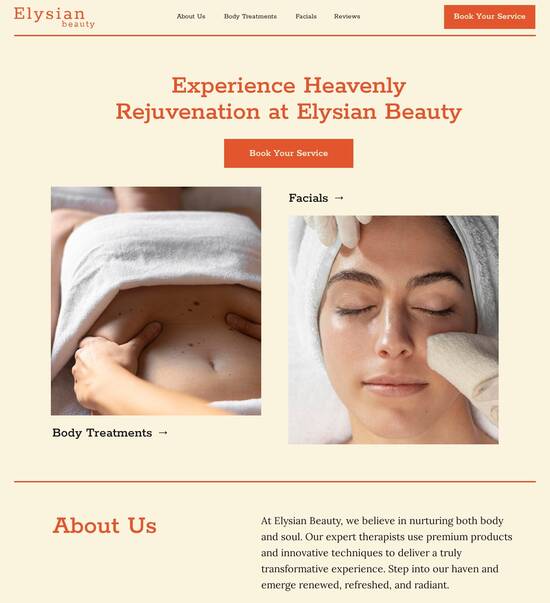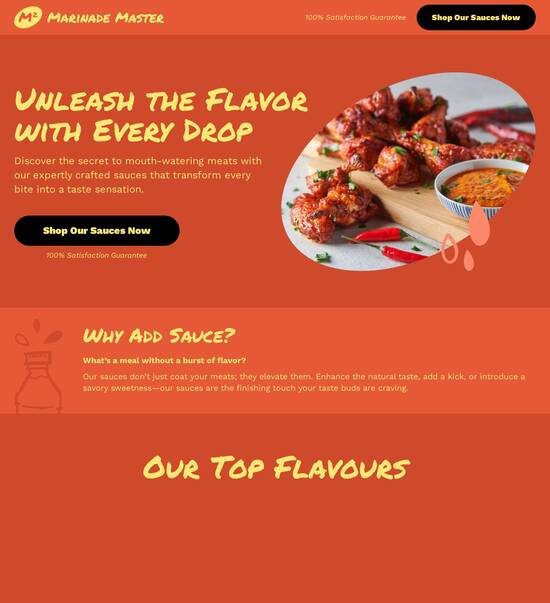
Lead capture page template for Node.js developers
Explore Similar TemplatesAbout template
Master your online marketing with this builder for lead capture page template for Node.js developers. Try more tools to create an immaculate landing page.
Recommended templates

Easy to build without coding
With the intuitive drag-and-drop builder, anyone on your team can create high-converting pages without any knowledge of code or design. Make enhancements to your landing page with custom widgets using Javascript, HTML/CSS, or third-party scripts.

Multiple layouts for any industry and goal
Select from 500+ landing page layouts built to boost conversions across industry-specific scenarios. Customize them by adjusting fonts, adding images, and generating on-brand content with the AI assistant. Quickly scale with Instablocks® and Global Blocks that you can save, reuse, and update globally.

Loads fast and looks polished on any device
Every template is responsive, which means they present professionally on any device and load blazingly fast with our Thor Render Engine. You can also power them up with Google AMP technology to deliver an unparalleled mobile experience and drive higher conversions.

Robust analytics & experimentation
Get real-time updates and reporting across all your devices, showing the number of visitors, conversions, cost-per-visitor, and cost-per-lead. Launch AI-powered experiments, run A/B tests, and use heatmaps to analyze user behavior, then optimize your landing page to maximize conversions.







Easy to build without coding
With the intuitive drag-and-drop builder, anyone on your team can create high-converting pages without any knowledge of code or design. Make enhancements to your landing page with custom widgets using Javascript, HTML/CSS, or third-party scripts.
Multiple layouts for any industry and goal
Select from 500+ landing page layouts built to boost conversions across industry-specific scenarios. Customize them by adjusting fonts, adding images, and generating on-brand content with the AI assistant. Quickly scale with Instablocks® and Global Blocks that you can save, reuse, and update globally.
Loads fast and looks polished on any device
Every template is responsive, which means they present professionally on any device and load blazingly fast with our Thor Render Engine.
Robust analytics & experimentation
Get real-time updates and reporting across all your devices, showing the number of visitors, conversions, cost-per-visitor, and cost-per-lead. Launch AI-powered experiments, run A/B tests, and use heatmaps to analyze user behavior, then optimize your landing page to maximize conversions.
All the features you need to build lead-generating landing pages
Explore more featuresLearn how to build top-performing landing pages for any goal
FAQs
Leading the way in building high-performing landing pages





A comprehensive guide on landing pages for marketers
Landing pages are critical for enhancing digital marketing strategies. Instapage offers powerful landing page templates specifically designed to meet the needs of marketers in various sectors. In this guide, we will explore how to create high-converting landing pages tailored for your specific goals and audiences, emphasizing the robust features of Instapage's platform.
Understanding the role of landing pages
Landing pages serve as a focused destination for conversions. Unlike general website pages, dedicated landing pages streamline user interactions towards one goal, whether that’s lead capture, product showcase, or event registration. Their significance lies in their ability to increase conversion rates by presenting relevant offers to targeted traffic.
- Increased conversion rates: Landing pages provide a clear call-to-action, encouraging visitors to act quickly.
- Enhanced targeting: Personalization elements allow you to connect with niche audiences effectively.
- Improved analytics: Monitor user behavior with built-in analytics tools, optimizing your approach continuously.
Selecting the right template for your goals
Choosing a landing page template is paramount. Instapage offers over 100 ready-to-use templates that cater to diverse marketing needs. Here’s how to select one:
- Define your objective: Determine whether you’re capturing leads, promoting a product, or announcing an event.
- Consider your audience: Select templates that resonate with the demographics of your target audience.
- Utilize A/B testing: Test multiple templates to identify which designs yield better performance.
Optimizing for higher conversions
To maximize conversion rates, optimization is essential. Instapage provides features that facilitate effective conversion rate optimization:
- A/B testing: Experiment with different headlines, CTAs, and visuals to find the most effective combinations.
- Heatmaps: Analyze user interactions on your page to understand where visitors are engaging most.
- Dynamic text replacement: Tailor messages in real-time based on user search queries to increase relevance.
By focusing on these key aspects, you can greatly improve the effectiveness of your landing pages.
In conclusion, leveraging Instapage's cutting-edge tools and templates significantly enhances your landing page's performance, leading to greater marketing success.
Start transforming your marketing campaigns today with Instapage. Discover our range of templates and features that empower you to achieve better results!
Lead capture page template for Node.js developers
Understanding the landscape of lead capture pages for Node.js developers
Lead capture pages serve as an essential component of the digital marketing strategy for any business, especially for Node.js developers. These pages are specifically designed to collect information from potential customers, often in exchange for something valuable, such as a free eBook or newsletter subscription. By focusing on lead generation through these specialized landing pages, businesses can build a valuable list of prospects that can be nurtured into customers, ultimately driving sales and business growth.
For Node.js applications, lead generation remains pivotal. A well-crafted lead capture page can significantly enhance conversion rates, turning casual visitors into engaged potential customers. Given the rapid growth of the tech industry, Node.js developers find themselves needing to integrate effective lead capture strategies into their applications to remain competitive.
What constitutes a lead capture page?
Significance of lead generation for Node.js applications
Unique challenges faced by Node.js developers
Creating effective lead capture pages does not come without its challenges. One common pitfall among Node.js developers is failing to design an intuitive user experience. A page that is cluttered or overly complicated can deter potential leads rather than attract them. Additionally, issues related to the integration of technologies can arise, particularly when trying to mesh Node.js applications with front-end frameworks or existing databases.
Moreover, a lack of experience in optimizing for mobile and desktop users can hinder lead collection efforts. Ensuring that lead capture forms and landing pages are fully responsive is crucial; otherwise, a large segment of potential leads could be lost due to poor accessibility on various devices.
Core components of an effective lead capture page template
An effective lead capture page contains several core components. Firstly, it must have a clear and well-structured HTML layout. Using essential HTML tags like , , , and not only provides semantic meaning but also aids in SEO efforts, contributing to the page’s discoverability online. Ensuring that each tag plays its role in organizing content helps both users and search engines navigate the page efficiently.
In terms of design, user interaction is pivotal. Forms should be simple and inviting, avoiding unnecessary fields that can frustrate users. The design should seamlessly fit into the overall aesthetic of the brand while also emphasizing the call to action. This not only improves user experience but can significantly increase the likelihood of form completion.
Key HTML tags and their roles in lead capture
Best practices for semantic HTML in lead capture pages
Designing for user interaction
Another critical aspect lies in designing effective forms that facilitate user input. This entails utilizing real-time data validation via JavaScript, which provides immediate feedback to users about errors in their submissions. Making use of placeholders and clear labels also enhances user experience, guiding users through the process.
Moreover, implementing responsive design principles is essential. Given the diversity of devices users employ today, ensuring compatibility across desktop, tablet, and mobile formats can maximize the reach and effectiveness of the lead capture page. Utilizing CSS frameworks such as Bootstrap can greatly simplify this process by providing pre-defined styles that adapt to different screen sizes.
The functionality behind capturing leads: technologies and frameworks
At the heart of lead capture functionality are technologies that enhance interaction. JavaScript plays a crucial role by enabling dynamic user feedback and real-time data validation. By leveraging libraries such as jQuery, developers can implement features that enhance the user experience during the lead capture process. Node.js complements this by managing server-side operations, processing form submissions efficiently, and connecting with databases to store lead data securely.
In addition to core technologies, integrating third-party APIs can significantly boost lead capture efforts. For instance, services like Mailchimp can facilitate email marketing initiatives, while CRM integrations, such as Salesforce, can help organize and manage leads more effectively. This seamless connection between the lead capture page and external services allows developers to focus on capturing leads without getting bogged down in backend processes.
Utilizing JavaScript for real-time data validation
Node.js for server-side processing of form submissions
Integrating third-party APIs and services
Utilizing third-party APIs not only speeds up lead capture processes but also opens new avenues for enhancing user engagement. Through APIs, developers can manage lead storage and provide users with insights into their submissions. For example, integrating a chat service like Intercom allows real-time engagement and timely follow-ups with leads, improving the chances of conversion. Additionally, connecting with robust databases simplifies lead storage management and provides easy access to user data.
Crafting compelling content to convert visitors into leads
High-quality content is at the heart of an effective lead capture page. This begins with strategic copywriting aimed at creating engaging headlines. The headline acts as the first point of contact for potential leads and should ignite curiosity while clearly communicating the value offered. A persuasive call to action (CTA) is also vital; it empowers users to take the next step while solidifying the message of what they gain by providing their information.
Alongside compelling copy, integrating visual elements is crucial. Images, videos, and even animations can enhance user engagement by breaking up text and adding visual interest. However, it's important to balance visual appeal with performance, ensuring that these elements do not hinder page load times. Compressing images and using optimized formats can mitigate this issue, ensuring that the page maintains fast loading speeds, further aiding in lead capture.
Writing engaging headlines that capture attention
Developing persuasive calls to action that resonate with users
Utilizing visual elements to enhance engagement
Including visual elements should not only focus on aesthetics but also relevance to the content offered. For instance, if your lead capture page promotes a tutorial, a short demo video can serve as an effective hook that encourages sign-ups. Striking the right balance between visual stimulation and ensuring a seamless user experience remains essential to maximize conversion rates.
Implementing backend systems: ensuring data accessibility and security
When it comes to lead capture, the backend systems play a pivotal role in managing user data. Setting up a robust database for lead management is crucial, where selecting the right technology, such as MongoDB or PostgreSQL, is vital based on project requirements. Developers should also consider how to structure data to ensure that information is easily accessible and retrievable for marketing and follow-up campaigns.
Equally important is emphasizing user data security and privacy compliance. Users need to feel confident that their information is secure, and as such, implementing strong encryption methods, secure storage practices, and staying updated with regulations like GDPR or CCPA should be non-negotiable. Establishing trust with users through transparency about data usage not only protects the business but enhances the likelihood of successful lead conversions.
Choosing the right database technology for your project
Implementing encryption and secure storage practices
Ensuring user data security and privacy compliance
Understanding regulations surrounding lead data is paramount. Businesses that collect user data must familiarize themselves with applicable laws to foster trust and retain users. Being transparent about how user data will be used creates a sense of safety and encourages sign-ups through reinforced trust.
Building the template: step-by-step development process
Building a lead capture page template involves a systematic approach to organization and development. By starting with a well-structured project layout, developers can ensure that the codebase is manageable and scalable. A suggested directory structure for Node.js applications typically includes folders for routes, models, and views. This organization allows for efficient collaboration, code maintenance, and easier implementation of new features.
Next, writing the template involves bringing together HTML, CSS, and JavaScript cohesively. Example code snippets can illustrate creating basic functionalities, such as forms with input validation and submission handling. Utilizing CSS frameworks speeds up the styling process, ensuring that the template remains elegant and user-friendly while reducing potential design inconsistencies across pages.
Recommended directory structure for Node.js applications
Essential files needed for rapid lead capture template development
Writing the template: HTML, CSS, and JavaScript integration
Testing and debugging processes are integral to developing a reliable lead capture page. Common issues developers face, such as incorrect data handling or visual misalignments, need to be addressed promptly. Adopting effective testing strategies—like unit testing and user testing—can help ensure not only the functionality of the lead capture systems but also provide insights into user experience, identifying areas for needed improvements.
Engaging with development communities: learning and growing
Engagement with Node.js development communities can amplify skills and knowledge. Major platforms such as GitHub and Stack Overflow provide opportunities for developers to share insights and troubleshoot problems collaboratively. Such engagement broadens understanding and encourages best practices in lead capture page development, ensuring that developers can stay updated with industry trends and tools.
Furthermore, actively participating in community discussions allows developers to refine and enhance their lead capture strategies. By revealing individual projects and seeking feedback, you gain invaluable perspectives that can elevate the overall quality of your applications. Crowdsourcing ideas and innovative techniques can ultimately result in more effective lead capture solutions.
Major online platforms where Node.js developers share knowledge
Benefits of participating in community discussions and collaborations
Utilizing online platforms for feedback and improvement
Online communities can also serve as a great resource for developers looking to innovate their lead capture techniques. Engaging with others not only allows for the exchange of feedback but opens the door for collaborations that can yield fresh ideas and methods that enhance overall lead generation. Utilizing various platforms to solicit and implement constructive criticism can significantly sharpen skills and lead to greater success in capturing leads.
Analyzing performance: metrics and optimization techniques
Analyzing the performance of lead capture pages helps developers understand their effectiveness. Key performance indicators, such as conversion rates and bounce rates, provide vital insights into user interactions and areas needing improvement. Utilizing tools such as Google Analytics can offer detailed metrics to help assess engagement levels on lead capture pages.
Moreover, continuous improvement strategies are essential for honing lead generation efforts. Implementing A/B testing enables developers to experiment with different visuals or copy to discover the most effective variations. Additionally, leveraging user feedback to make ongoing enhancements can create a more user-centric experience, ultimately leading to higher conversions.
Understanding important metrics: conversion rates, bounce rates, etc.
Tools to monitor and analyze page performance
Continuous improvement strategies
Lastly, harnessing user feedback can illuminate insights into the effectiveness of lead capture strategies. Regularly reviewing user considerations can guide crucial adjustments that bolster engagement and lead conversion rates. Fostering a mindset of continuous learning and adaptation is key to maintaining an effective lead capture approach.
Future trends and innovations in lead capture for Node.js developers
The landscape of lead generation is constantly evolving, influenced by emerging technologies such as AI and machine learning. These innovations can be applied to personalize lead capture experiences and automate customer interactions, ensuring users receive tailored content that resonates with their needs. Node.js developers who stay ahead of the curve by integrating such technologies into their pages can significantly enhance user engagement and conversion rates.
Furthermore, adapting to changing user behaviors remains critical to a successful lead generation strategy. As user preferences shift, developers must be prepared to pivot their approaches. Analyzing trends in user engagement can offer insights into what adjustments may be needed to keep pace with changing demands, further solidifying the importance of innovation in lead capture strategies.
The impact of AI and machine learning on personalizing lead capture
Exploring automation tools to streamline lead management processes
Adapting to changing user behaviors
As a closing note, developers must always keep a finger on the pulse of new trends and tools that can enhance lead capture pages. Emphasizing adaptability will enable developers to maintain relevance and competitiveness in the lead generation sphere. Making informed decisions based on user engagement trends will allow developers to optimize their approach continually and capture more leads effectively.
Real-world use cases: success stories from Node.js developers
Examining case studies that highlight successful lead capture implementations can offer valuable insights for Node.js developers. Notable projects that initially struggled to capture leads often found success through tailored lead capture pages that resonated with their target audience. These transformations typically involved thoughtful evaluation of user needs, resulting in strategies that effectively increased lead conversion rates.
The lessons learned here emphasize the importance of testing various strategies until a successful model is implemented. Many developers observed improved performance through quick iterations and by fostering a culture of continuous improvement that allows for adapting to user feedback influenced by different geographic and demographic elements.
Discussing notable projects that successfully utilized Node.js for lead capture
Lessons learned and strategies employed for increased lead conversion rates
Community contributions: templates and tools available
Open-source resources can also be a treasure trove for developers in search of effective lead capture templates. By tapping into the creativity of the development community, Node.js developers can find shared tools and templates specifically designed to enhance lead generation efforts. Adapting these resources to meet individual project needs can fundamentally change how leads are captured, ultimately streamlining the process and improving outcomes.
Ready to skyrocket conversions?
Supercharge your ad campaigns with high-performing landing pages
Get started














